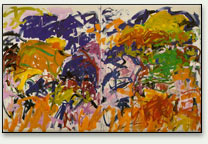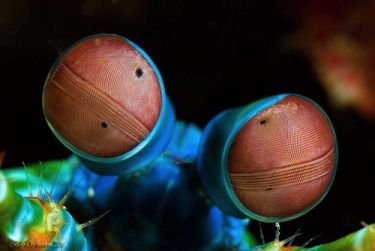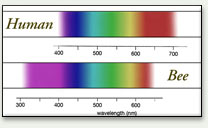A page from the "Causes of Color" exhibit...
What colors do animals see? (speculation)

We do not know what animals see. Many researchers think that animals "understand" little of what they see, just as humans rarely "understand" abstract expressionist paintings, such as "Ici" by Joan Mitchell (1992).
What colors do animals see?
Does a bull really get enraged by a red cape? How do bees know which flowers are plump with nectar? Why does your cat see and pounce upon an insect before you’re even aware of it? In short, what, exactly, do animals see - and do they see color? While no one knows exactly what animals see, there are several aspects of the question that beg exploration. We not only need to know how their eyes work from a physiological perspective, but also the spectral sensitivities of the photo-pigments present and how their brains perceive color.

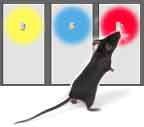
It is challenging to find ways to test the color perception of animals. Commonly, animals are trained to associate a particular color with a reward. Impartial testing also requires that any non-visual clues, such as subconscious prompts from the tester, be eliminated.
Researching color vision in animals
Many animals can see things that we cannot. For example, cats rely on their night vision to give them an advantage as they hunt for prey, while our human ancestors - who couldn’t see well in the dark - sought safe refuge at night and hunted during the daylight hours. Although we know that sight differs among animals, we do not know what animals actually perceive. There is an important distinction between having light illuminate the retina, and understanding what is being seen. Color vision and perception across the animal kingdom is the subject of much ongoing research, as we have a very limited understanding of the many ways animals see.
The dance of the honeybee has been researched extensively, so we have a relatively good understanding of the color vision of bees and related insects. Mosquitoes and flies have been studied because of their role in spreading diseases, and it has been shown that they are attracted or repelled by specific surface colors, and by specific colored sources of light. Interestingly, the surface colors they prefer do not necessarily correlate with the light source colors that attract them.
Vision across the animal kingdom
There is an enormous diversity in the retinal structure and neuronal mechanisms across the animal kingdom, and a corresponding diversity in the role of color vision in animals’ perception, behavior, and interactions with the environment. Amongst invertebrates, eyes themselves take on a startling variety of shapes, forms, and numbers.
Light sensitivity has been observed in organisms such as amoeba; their activity levels change with varying light conditions. Earthworms have simple light receptors, enabling the earthworms to react and tunnel back into the earth immediately when they are exposed to the multiple hazards of sunlight, which include dehydration and predators.
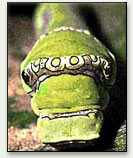
Eyespots on the Tanzanian caterpillar. Head coloring and fake eyes resemble those of a snake, warning off predators. The caterpillar’s real eyes are small, barely visible, and located near the snout. Earthworms and caterpillars have "eye spots," and see only light and dark, helping them stay out of the hot sun. |
Some of the most complex eyes in the animal kingdom belong to the mantis shrimp, a predatory crustacean living on the ocean floor. |
At the other end of the spectrum, the mantis shrimp has complex eyes with more than double the number of ommatidia (simple, cone-shaped lenses) found in bees, and with at least a dozen distinct photoreceptors. A possible reason for the complexity of these eyes is that much of the color processing occurs in the eye itself, rather than in the brain. By contrast, our eyes send raw visual data to the brain, where it is processed so that we can make sense of it. There is no particular advantage to either system; the shrimp have just evolved in a completely different way.
The honeybee has complex eyes consisting of over 5000 ommatidia. Within each ommatidium, the visual cells that detect color are arranged like orange segments around a central core.
The range of vision for the bee and butterfly extends into the ultraviolet. The petals of the flowers they pollinate have special ultraviolet patterns to guide the insects deep into the flower.
Comparison of wavelengths visible to humans and bees. Four of the visual cells in each ommatidium respond best to yellow-green light (530 nm); two respond maximally to blue light (430 nm); and the remaining two respond best to ultraviolet light (340 nm), allowing the honeybee to distinguish colors (except red).
Fish appear to have quite well developed visual systems, comparable in some species to those of birds. Some have photoreceptors with peak sensitivities in the ultraviolet range. This may be because, like birds, they move about in a blue environment and need to contrast food sources or predators against a blue background.
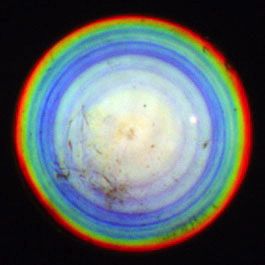
A schlieren photograph shows the zones of a fish lens that focus different spectral ranges (colors).
Vision systems in deep-sea fish differ from those of fish nearer the surface, as ambient light loses intensity and shifts towards blue with increasing depth. This forms another area of fascinating ongoing research. Until recently it was believed that deep-sea fish were unable to see red light, as these wavelengths are filtered out before reaching deep water. It turns out that a variety of these fish fluoresce in red, and this fluorescence is visible for short distances. This means that red light has some function for deep-sea fish, perhaps to alert other fish to their whereabouts, or their direction of gaze, and that their vision probably does extend to red wavelengths.
Color vision in reptiles is also well developed. Certain species of snake have thermal pits in addition to their eyes, extending their spectral range into the infrared. This assists them in identifying potential prey, or predators, from their low-to-the-ground perspective.
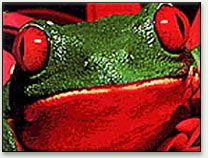
This Costa Rican red-eyed tree frog has a very limited visual pathway; its neural behavior and jumping reflex suggest it only "sees" its prey if it is moving.
While mammals have relatively weak color vision, humans and other primates have the most advanced color perception in this class. Dogs have two identified types of cones, suggesting they are dichromats with similar peak sensitivities to red-green colorblind humans. Cats are trichromatic, but have a much lower proportion of cones to rods than humans. In addition, dogs and cats have a much more highly developed sense of smell than humans. While we rely primarily on sight, their perception of the world is far more reliant on olfactory stimuli.
Interestingly, bulls are not able to distinguish color and would see the bullfighter’s red cape in shades of gray. They follow its movements, but do not perceive it as red - the red color is only useful in its effect on the human spectators, as illustrated in this representation of a bullfight by Edouard Manet.
What we know about color perception in the animal kingdom pales in comparison to that which is yet to be discovered. Of species studied so far, the best color vision appears to be found in birds, aquatic creatures, and certain insects. Amongst insects, we know that butterflies and honeybees have advanced color discrimination.




